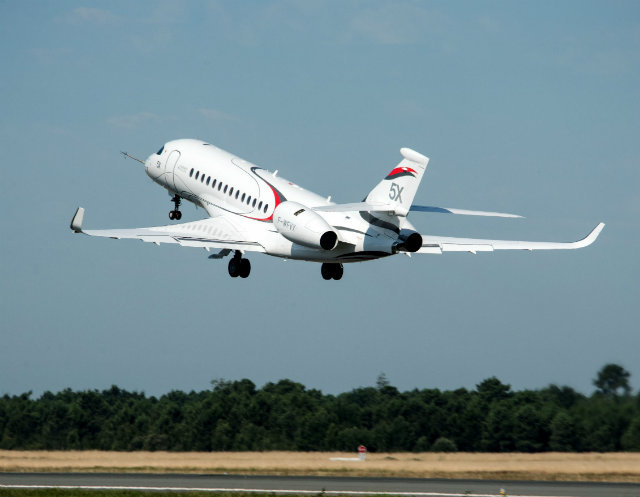A “serious” new problem discovered five years into testing the Safran Silvercrest engine has shaken Dassault Aviation’s confidence and raised questions about the future of France’s only hope to remain one of the world’s few designers of turbofan propulsion systems.
A clearly displeased Dassault chairman and chief executive, Eric Trappier, declined to offer an explicit commitment to remaining with the Silvercrest for the large cabin Falcon 5X when asked during a 9 October news conference if he would start considering other engine suppliers.
“It’s too early to say. We are trying to fix the problem with Safran. We are trying to keep all options open,” he says.
As more questions were raised about details of the new problem, Trappier called on Safran vice-president of commercial engines Cédric Goubet, who was seated among a standing-room only press conference audience, to come to the front of the room and respond.
At first, Goubet attempted to emphasise the positive. The fixes put in place to resolve a previous two-year delay with the Silvercrest – involving oil-fuel heat exchanger problems and clearance controls in the high-pressure core of the engine – appeared to be working as the Falcon 5X passed 50h in flight test since a debut sortie on 5 July, he says.
But Safran has discovered a new problem in data from the company’s San Antonio-based flying testbed and in simulations on the ground, he says. The data shows new problems with acceleration and deceleration of the engine at high altitude and low-speeds, he adds.

Dassault
The cause of the problem discovered five years after Safran delivered the first Silvercrest engine to test in September 2012, remains under investigation. As that evaluation continues, Trappier says, the impact of the problem is not clear, but Dassault expects entry-into-service to slip even further beyond 2020.
Despite Dassault’s clear frustration over the new setback, Safran’s other customer for the Silvercrest engine remains supportive. Textron Aviation selected the Silvercrest to power the original version of the Citation Longitude, which was launched with a 4,000nm (7,400km)-range goal. But Textron dropped the Silvercrest two years ago when it redesigned the Longitude to fly up to 3,500nm. Instead, the company selected Safran’s turbofan to power the new Citation Hemisphere, which is scheduled to achieve a first flight in 2019 with a goal to fly up to 4,500nm.
“We’re very confident in [Safran] as a partner,” says Textron Aviation senior vice-president of engineering Brad Thress. “A lot of that should be well behind them before we get to that point of our programme.”
But the Silvercrest’s development problems plague Safran’s plans to remain a full-service developer of modern turbofan engines. The company last delivered a full engine for the Dassault Rafale about 20 years ago. Its largest business involves supplying the low-pressure sections of the CFM International CFM56 and next-generation Leap engines. But the Silvercrest represents the first engine to feature a Safran-designed low-pressure and high-pressure section since the Rafale’s M88.
Safran approached the design of the Silvercrest with a unique architecture for a turbofan engine in the 10,000-12,000lb-thrust engine class. Such engines usually feature a compressor design with axial airflow, meaning the air passes in a straight line through the compressor. Smaller engines ranging up to about 7,000lb-thrust often use a different architecture, with the airflow passing axially through the first several stages of compression and then passing around – or centrifugally – over the last stage of compression. Despite the size of the Silvercrest, Safran selected an axial-centrifugal architecture.
Company officials have explained the decision as a chance to make a breakthrough in propulsion efficiency in the 10,000-12,000lb-thrust power category. If an axial-centrifugal architectecture can be made to work at such thrust levels with the Silvercrest, Safran could deliver a step-change in fuel efficiency to a segment of the market that currently has no other modern alternatives.
But it’s becoming increasingly clear that such an architecture is more complex to achieve than Safran expected. The Silvercrest architecture can still deliver a breakthrough, but it must overcome the latest setback.
Safran’s competitors may not wait long. Pratt & Whitney Canada president John Saabas acknowledges the company currently doesn’t have an engine to offer Dassault as an alternative, but that could change. The core of the 15,000lb-thrust PW800 might be adapted to the 10,000-12,000lb-thrust category. Likewise, Honeywell could revive development of the HTF10000, a cancelled rival to the Silvercrest. Finally, Dassault originally selected Rolls-Royce to power the “SMS” concept in 2008, before the project was re-scoped and unveiled as the Falcon 5X.
Source: FlightGlobal.com



















